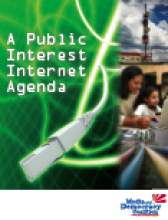
Fast, affordable Internet access for all.

Burlington Telecom has popped up on our radar before as one of those munis that goes the extra mile for the community. They’re at it again this holiday season as they pledge to help support local charities.
From now until the end of the year, Burlington Telecom will donate $100 to a Burlington based non-profit for each new customer subscribing to BT Internet, television, or phone services.
Customers will have the choice to direct BT’s donation to one of five organizations: Committee on Temporary Shelter, Community Health Centers of Burlington, Howard Center, Spectrum Youth & Family Services, and Steps to End Domestic Violence.
As a bonus, an additional $25 will be donated for any current Burlington Telecom customer who uses BT’s Refer-a-Friend Program.
Record Of Care
We’ve covered their past decision to launch a computer repair service so customers had somewhere local to get hardware advice. In 2011, BT announced a partnership with a local nonprofit to provide affordable computers to local families. Recently, BT began offering free Wi-Fi in the city’s transit center so travelers could stay connected.
Locals Want Local Interest
Keep BT Local! is a cooperative started by Burlington residents and businesses that are raising capital to purchase the network from Blue Water LLC, the company that currently owns the assets. When CitiBank sued the city for $33 million, the settlement agreement required that a third party (eventually Blue Water) take temporary ownership and the city lease the network until they could agree on a permanent buyer.

Download Breaking the Broadband Monopoly [pdf]

Policy should promote competition, innovation, localism, and opportunity. Locally-owned and -operated networks support these core goals of Federal broadband policy, and therefore should receive priority in terms of Federal support. Structural separation of ownership of broadband infrastructure from the delivery of service over that infrastructure will further promote these goals.The report also touches on other key issues - including Universal Access, a non-discriminatory Internet (network neutrality), symmetrical connections, and privacy. But the most important focus from our perspective is that of localism:
For decades, American communities — both rural and urban — have been neglected and underserved by absentee-owned networks, whose business models clearly do not work in smaller or economically challenged communities. By contrast, in the communities in which they are based, locally-owned networks are more likely than absentee-owned networks to provide rapid response to emergencies, enhanced services, and value-added, social capital benefits such as job-training, youth-mentoring, and small business incubation. In addition, local networks are less likely to outsource jobs, thereby strengthening local and regional economies, while creating more opportunities for community-based innovation and problem-solving. Federal broadband policy that prioritizes support for local networks will produce more competitive markets, consumer choice, and opportunities for innovation.The first two recommendations in this section calls for federal policy that discourages absentee ownership:
- To fulfill the goal of extending broadband service to un- and underserved areas, federal broadband policy should prioritize support for locally-owned and -operated networks, including those owned by local governments, nonprofits and cooperatives, and public-private partnerships.
To make sure the broadband service is clearly expressed, the Broadband Truth-in-Labeling disclosure should be standardized to comprise several typical elements as indicators of broadband service quality, such as minimum expected speed and latency to the ISP's border router (where the ISP connects to the rest of the Internet) and service uptime. These minimum assurances will be supported by the ISP as guarantees in the delivery of broadband services, backed by technical support and service charge refunds or credits. In addition to the description of minimums being guaranteed of the service, the disclosure should include all applicable fees, a common description of the technology used to provide the services, any service limits such as a bandwidth cap or the application of any traffic management techniques, the length of the contract terms, and a link to all additional terms and conditions. Requirements should be established for disclosing any highly objectionable or surprising terms such as arbitration restrictions or information or data selling.
The key metric for broadband should be the applications and needs that drive consumer requirements and choices. In this way, broadband should be understood as a connection that is sufficient in speed and capacity such that it does not limit a user’s required application.Their magic broadband number is a reasonable and doable 10Mbps symmetric connection for residential and small businesses as well as a 1Gbps level for enterprise users. Importantly, they note that a single broadband connection supports far more than a single computer or use - these connections are shared, often among many wired and wireless devices. Compare these comments to those of the NCTA [pdf] (lobbying organization for cable companies) that argue broadband is nothing more than an "always on" connection regardless of the speeds or user experience. This is how they justify maintaining the international laughingstock definition of 768kbps/200kbps.